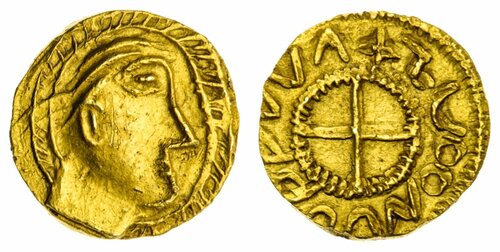
Auction: 21000 - The Tony Abramson Collection of Dark Age Coinage - Part I (conducted behind closed doors)
Lot: 17
Anglo-Saxon England, Crondall Types (c. 630-650), Gold Shilling, 'Substantive Gold' Phase, London derived, crude bust right, with large features and hair swept back, striated halo forms border, rev. +ZUOONUUPLUV^. blundered legends, cross in beaded circle, 1.26g, 270° (SCBI 69, 1 this coin; T&S 22-31, pp. 41 and 59-60; A&W xi; Gannon 30, Figs. 2.9a and c, and 5.5g; North 22; Spink 754), a most attractive and provocative example of Anglo-Saxon portraiture, a small scuff on cheek and trace double-striking to reverse, otherwise good very fine, extremely rare, a truly superb centrepiece and the finest to appear in public commerce
M Vosper, March 2012
~ Found by Mike O'Bee 'north of Horncastle' (Essex), 28 November 2011 ~
[EMC 2011.0275]
Sutherland has discussed the derivation of this type from the forward-facing portrait type with a clear reverse inscription of LONDVNIV. The influence of this type on the subsequent 'London-derived' group 'is to be seen most clearly in their conspicuously linear technique, in the adoption of a cross-hatching border for the obverse in the use of a plain cross as the central reverse type, and in the employment of a reverse legend which, enclosing the cross, strongly suggests by its blundered lettering that some form of the name 'Londinium' or 'Lundonia' served as a basis for imitation.' (ASGC, no. 43)
Academic debate as to further attribution and dating has raged for more than a century. In 1915, Baldwin Brown opined: 'if struck in London with [its] ecclesiastical significance, the piece might conceivably be the work of Mellitus during his tenure of the See [604-c.617], and the head [depicts] that of an Archbishop'. More recently Anna Gannon has regarded this attribution as anachronistic as she reopened the discussion at the Cambridge Symposium (March 2015). It was suggested that this Shilling, if of Bishop Mellitus (d. 624), could be twinned with those shillings of York, possibly by Edwin (d. 633) or Paulinus. In the context of the celebrated issue of Eadbald of Kent (616-640) imply a date earlier than c. 630 for the reintroduction of this native coinage to England, and possibly as far back as the Kentish kingdoms conversion to Christianity in AD 619.
Subject to 20% VAT on Buyer’s Premium. Not applicable to "Buy Now " offerings. For more information please view Terms and Conditions for Buyers.
Sold for
£29,000
Starting price
£7000




